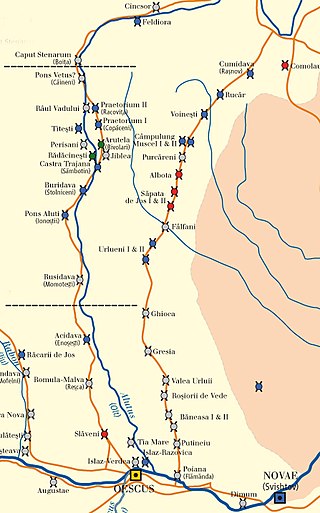
Located in Roman province of Dacia, present-day Romania, the Limes Porolissensis was a frontier of the Roman empire in Dacia Porolissensis, the northernmost of the three Dacian provinces. It was a defensive line dating from the 2nd century AD after the Conquest of Dacia. The frontier was a complex network of over 100 observation towers, fortlets, walls and forts disposed in a line over 200 km from the Apuseni Mountains to the Eastern Carpathians, following the highland chain of the Meseș Mountains.

Amutria was a Dacian town close to the Danube and included in the Roman road network, after the conquest of Dacia.

Ad Mutriam was a fort in the Roman province of Dacia in the 2nd century AD.

Castra Buridava was a fort in the Roman province of Dacia, part of the frontier system of the Limes Alutanus, and near the Dacian and Roman town of Buridava.

Jidava was a fort in the Roman province of Dacia 4 km southwest of the town of Campulung, Romania. It was built around 190–211 AD as part of the frontier system of the Limes Transalutanus located approximately 20 km south of the Rucÿr-Bran pass.
The fort was part of the defensive system of the Roman province of Dacia in the 2nd and 3rd centuries AD. The ruins of a contemporary nearby defensive ditch was also unearthed. It is located in Abrud (Romania).

The Castra of Călugăreni was a fort in the Roman province of Dacia located on the north-western periphery of the modern village of Călugăreni, Romania. The fort was built in the 2nd century AD and abandoned in the 3rd century. Archaeological research also proved the existence of a nearby canabae.
The castra of Poiana was a fort in the Roman province of Dacia near the present town of Poiana. It was built in the 2nd century AD and abandoned in the next century. It was a part of the Limes Transalutanus frontier system and situated at the southern end next to the Danube.

The Castra of Ighiu was a fort made of earth in the Roman province of Dacia. Its dating is uncertain. The traces of the earthwork can be identified on the Măguligici Hill in Ighiu (Romania).
It was a fort in the Roman province of Dacia and part of the Roman frontier system of the Limes Transalutanus.
The castra of Crâmpoia was a fort in the Roman province of Dacia. It was made of earth in the 2nd century AD. The Romans abandoned the fort in the 3rd century. Its ruins are located in Crâmpoia, Romania.
The castra of Costești was a fort in the Roman province of Dacia. Erected and abandoned by the Romans at an uncertain date, its ruins are located in Costești on a hilltop, at an altitude of 1203 meters.

The castra of Târsa was a temporary fort erected by the Romans during the Trajan's Dacian Wars.
The castra of Fâlfani was a fort built in the 2nd century AD in the Roman province of Dacia. It was part of the Roman frontier system of the Limes Transalutanus.

Gresia Roman fort is located in the present Gresia. It was in the Roman province of Dacia and dates from the 2nd and 3rd centuries AD. It was part of the frontier system of the Limes Transalutanus.
The castra of Livezile was a castra in the Roman province of Dacia, located in the north side of the modern commune of Livezile in the historical region of Transylvania, Romania. The fort was erected and surrounded by a ditch in the 2nd century AD. The castra was abandoned in the 3rd century and its ruins are still visible.
The castra of Pinoasa was a fort in the Roman province of Dacia. Matei Dan dates the castra to the period of the Dacian Wars. Its ruins were destroyed by excavations at the Rovinari Coal Mine.

Castra of Titești was a fort in the Roman province of Dacia near the Limes Alutanus on the west bank of the Olt River.

In Roman Dacia, an estimated 50,000 troops were stationed at its height.
This page is based on this
Wikipedia article Text is available under the
CC BY-SA 4.0 license; additional terms may apply.
Images, videos and audio are available under their respective licenses.










